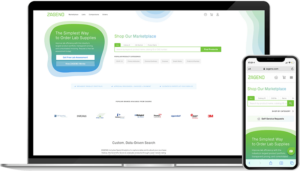9 Steps to Vet Suppliers for Your Lab

What happens when your PunchOut catalogs don’t have the supplies that your lab needs? Usually, the scramble begins to find a vendor, any vendor, with the necessary lab supply in stock.
| However, proper lab supplier selection takes time and research. Business must be awarded on more than just faith and convenience. |
The supplier vetting process sets the tone for your future relationship. When done right, it garners stakeholder buy-in and ensures lower pricing, better delivery terms, enhanced customer service and more. When rushed, you lose leverage, leave money on the table and increase the risk of delivery and/or quality issues, which usually results in having to look for a different vendor in the not-so-distant future.
Here are 9 steps to follow when vetting suppliers / vendors for your lab:
- Research internally and externally. Analyze your company spend on this type of product. Who are your suppliers and what do you spend with each? Do an industry analysis. Who are the key suppliers providing what you need? Perform a competitive analysis to determine best practices, what your competitors are doing, and where you fall in the spectrum.
- Craft a weighted criteria decision matrix. Meet with stakeholders to collaboratively identify and assign weights to supplier qualification criteria.
- Draft and send out a request for information (RFI). Include a mix of quantitative and qualitative questions that cover must-haves and nice-to-haves. Must-haves may include vendor quality certifications, service levels, rush delivery policies, and reject rates.
- Eliminate candidates that don’t measure up. Evaluate each supplier’s response according to whether it ticks all of your must-have boxes.
- Draft and send out the RFx. This step in the competitive bidding process can be called a request for quote (RFQ), request for bid (RFB), or request for proposal (RFP). This is the vehicle to inquire about cost, rebates and/or volume discounts, and payment terms. Some source-to-pay (S2P) systems can do reverse auctions, where contenders compete on price.
- Distribute and evaluate RFx responses. Using your decision matrix, all stakeholders individually evaluate responses, which are then aggregated, analyzed, and discussed.
- Refine, follow-up, and negotiate. If necessary, go back to suppliers still in the running with follow-up questions and clarifications. Negotiate as needed.
- Select the winner, then undergo the contracting process.
- On-board supplier and stakeholders. Set up the new PunchOut catalog, adjust purchase order and invoicing processes, and train stakeholders accordingly.
End-to-end, this process can take a long time and be very manual. Thoroughly vetting suppliers requires significant lead time and must be done in a way that minimizes supply chain risk and reduces supplier switching costs, if applicable. The paradox is that time is not a luxury the lab usually has.
Complicating matters, some life sciences and biopharma companies may still be using clunky spreadsheets to solicit, compare, and evaluate bids.
| Some S2P and procure-to-pay (P2P) systems partially automate the supplier selection process and reduce cycle time. Self-service eCommerce marketplaces like ZAGENO make it even faster to find products by offering labs the ability to browse products from multiple, qualified vendors on the same platform, with real-time availability information and streamlined invoicing. |
While we may feel tempted to rush through the supplier selection process, especially when it comes to long-tail spend, we pay for it in the end. Proper, efficient supplier vetting is crucial to drive lab costs down, increase delivery reliability and accelerate product development.


